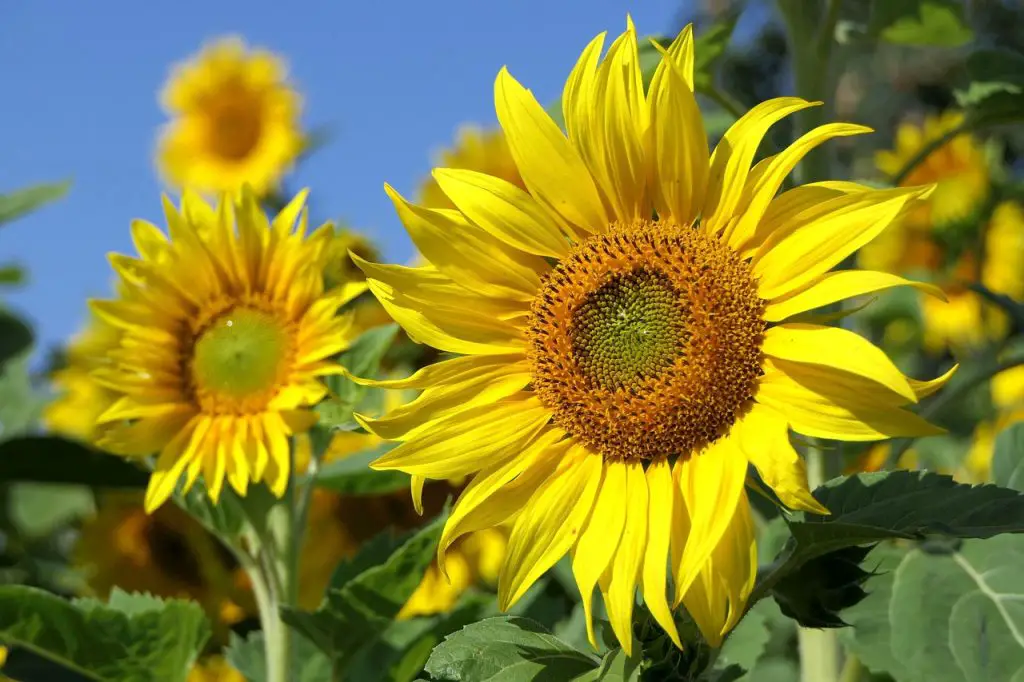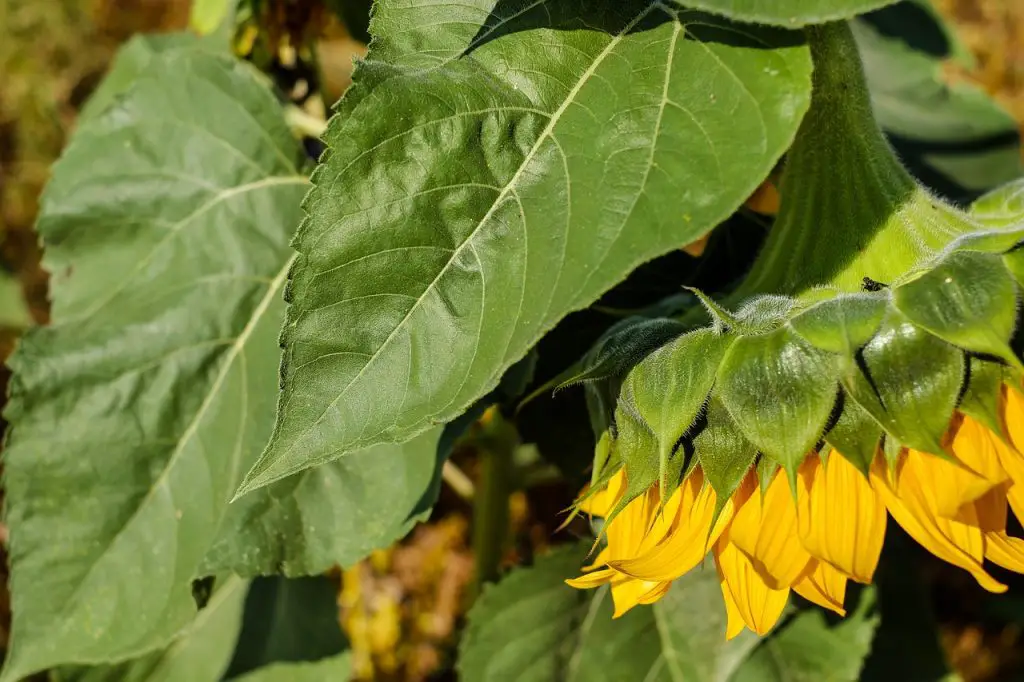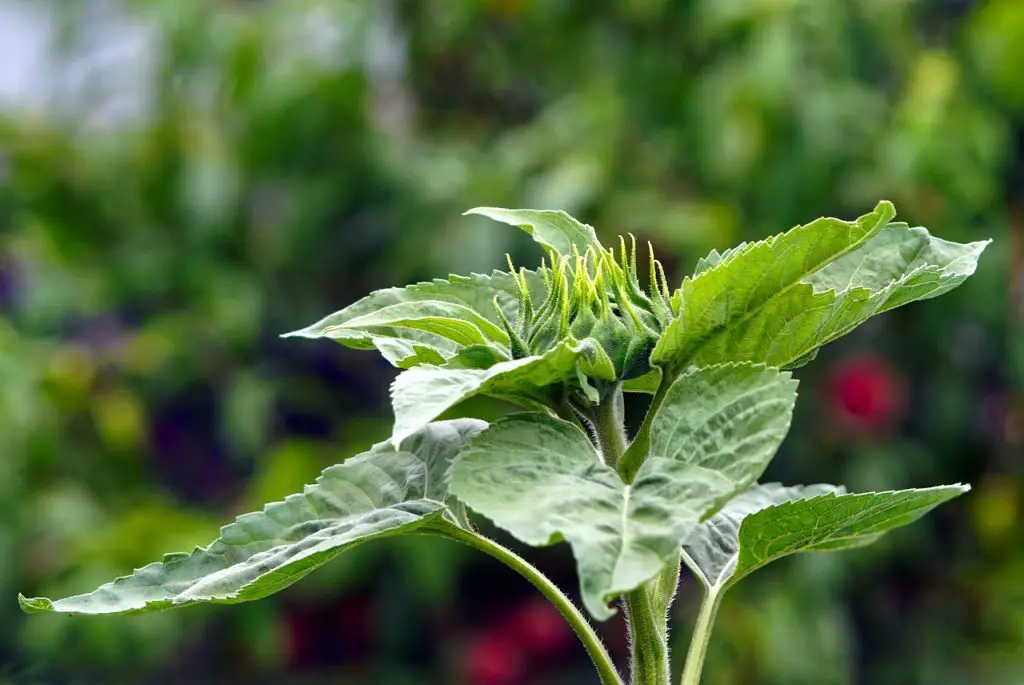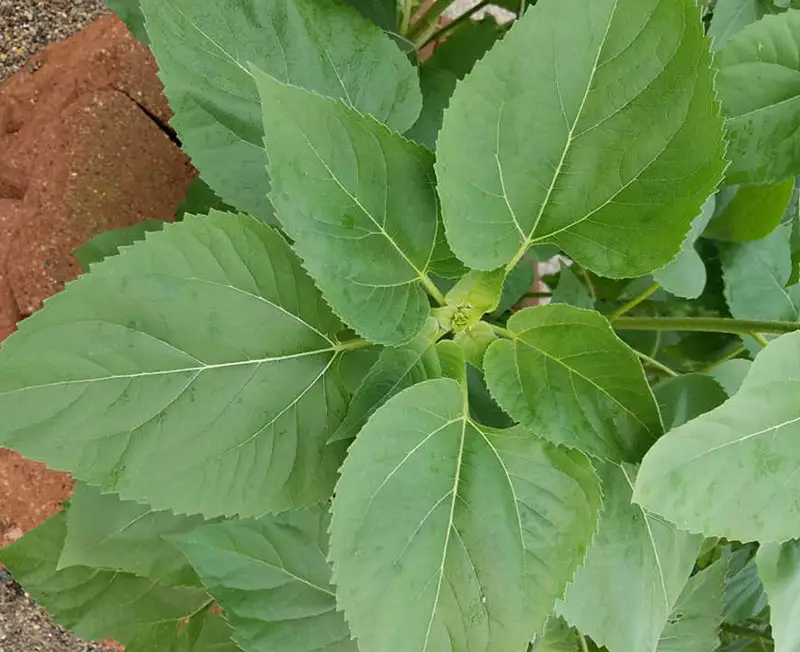Sunflowers are some of the most iconic plants, known for their brilliant yellow petals and cheerful faces. But beneath these vibrant blooms lies a complex leaf network that provides food and energy to the plant. As a garden enthusiast, I am often asked ‘What kind of leaves do sunflowers have?’ Therefore, I am here to explore the anatomy and purpose of sunflower leaves as well as how they help nourish our planet.
The first thing one must know about sunflower leaves is that there are two distinct types: cotyledons and true leaves. Cotyledons are the seedling’s initial source of nutrition; stored within them is everything needed to kickstart growth until photosynthesis can take over. True leaves then emerge from growing stems shortly after germination has taken place – these foliar structures are responsible for transforming light into food through photosynthesis. Both types play an integral role in sustaining life on earth by producing oxygen and storing carbon dioxide; without them, ecosystems would collapse!
Understanding what type of leaves grow on sunflowers helps us better appreciate their vital importance to our world. Their ability to capture solar energy and convert it into usable nutrients makes them essential components of any healthy ecosystem – not just those containing flowering plants.
What Do Sunflower Leaves Look Like?
Sunflowers are a beloved sight in many gardens, and their foliage can be just as impressive. Sunflower leaves have an unmistakable appearance that makes them stand out from other plants. They are large, oval-shaped with saw-toothed edges and dark green on the top side while being lighter underneath.
The veins of the leaf run parallel to each other and form a characteristic V shape when viewed from above. These features make sunflower leaves easily identifiable for any plant enthusiast or botanist. Interestingly enough, these same characteristics also serve as natural solar collectors which help the plant absorb more energy from the sun. This is why it’s not surprising to find sunflowers growing in areas where there is good sunlight exposure; they need this light to thrive.
How Many Leaves Does Sunflower Have?
Sunflowers possess long, thin leaves that grow in an alternating pattern around the stem. Depending on the type of sunflower, they can have anywhere from 8-21 leaves per plant. The length of each leaf is variable and may reach up to a foot or more depending on the species.
The leaves contain multiple veins for transporting water and nutrients throughout the plant structure. They are typically green in color but those with certain genetic traits may appear yellowish or even reddish due to anthocyanin pigments present in their cells.
In contrast to other plants, these leaves do not wilt when exposed to direct sunlight as they have adapted over time through natural selection processes to withstand strong solar radiation levels without damage. This evolutionary trait ensures that adequate energy is available for photosynthesis and flowering occurs regularly during the summer months.
What Is The Colour Of Sunflower Leaves?
Sunflower leaves are typically a greenish-gray color. They have a silvery, fuzzy feel to them and can range in size from 1/2 inch to 3 inches across. Interesting fact: sunflowers’ leaves usually turn yellow when the flower is pollinated by bees!
Here’s what you need to know about the color of sunflower leaves:
- Sunflower leaves are generally gray or silver-green in color.
- The undersides may take on a more bluish hue as they mature.
- When pollinated, their edges become tinged with yellow near the center of the plant.
The texture of sunflower leaves can also vary depending on their age and environment; some plants may develop rough surfaces while others remain smooth throughout their life cycle. But even those that possess a rougher surface still maintain the characteristic silvery sheen that makes them so attractive to gardeners looking for an interesting addition to their landscape design.
Do Sunflowers Have Rough Leaves?
Sunflower leaves are generally green in color, with a smooth texture. The surface of the leaf is usually slightly glossy and has no visible hairs or prickles. However, this does not mean that sunflowers do not have rough leaves. Upon closer inspection, some varieties may be seen to have small bumps on their surfaces, giving them a rougher feel than other types of plants.
The structure of the leaves varies based on the variety of sunflowers as well. Different species will often feature different shapes and sizes due to varying levels of adaptation over time. Some varieties may grow larger leaves while others might produce smaller ones; there’s really no one-size-fits-all when it comes to sunflower foliage!
Depending on the variety, some sunflowers may also display serrated edges along their margins. These sawtooth patterns can add an additional layer of complexity to the overall look and feel of the plant’s leaves – making for truly stunning specimens in any garden setting! With all these factors taken into consideration, it becomes clear why many botanists consider sunflowers such beautiful and diverse members of the flower family.
Although each individual specimen may differ from another in terms of its leaf shape and size, most agree that they all make excellent additions to any outdoor space or living environment – offering visual interest and adding a touch of nature’s beauty wherever they’re planted.
What Is The Leaf Venation Of Sunflower?
Sunflower leaves are generally ovate to lanceolate in shape. They possess a distinct venation, with two main veins extending from the base of the leaf and branching off into several lateral veins towards the tip. The upper surface is slightly rough while the underside features more prominent tubercles or bumps along its mid-vein.
Sunflowers also display an arrangement called ‘pinnate’ venation; this means that their secondary veins emerge alternately on either side of the central vein instead of forming a network like other plants do. This unique pattern helps distinguish sunflowers from many other species. In addition, sunflowers have small stipules at their leaf bases which act as protective sheaths for new growth.
The overall structure of a sunflower’s leaves allows them to efficiently capture sunlight and maximize photosynthesis efficiency. With their specialized venation system and specially adapted shapes, these flowers can thrive in dry climates where resources may be scarce. Thus, they are well suited to areas such as desserts or high altitudes where other plant life would struggle to survive.
The combination of sharp edges and shallow serrations on the margins give sunflower leaves added strength against strong winds without sacrificing flexibility, allowing them to sway gently without breaking apart easily – perfect for adapting to changing conditions quickly! As we now know, sunflowers have specific characteristics that make them particularly adept at surviving harsh environments.
Are Sunflower Leaves Smooth?
Sunflowers boast large, majestic leaves that are sure to captivate onlookers. They appear so delicate and fragile, one could almost imagine they’re made of silk! But looks can be deceiving; sunflower leaves actually have a rather rough texture.
Using the naked eye, we can observe tiny bumps or ridges on the surface of sunflower leaves. In addition, these leaves contain small hairs which give them their signature velvety feel when touched. The outer layer acts as a protective shield against harsh temperatures and UV rays for the plant underneath it.
At closer inspection under a microscope, however, one will find an even rougher terrain than expected: grooves, indentations, and spikes all contribute to the unique topography of each leaf’s surface. Despite this seemingly rugged composition, sunflower leaves serve an important purpose in protecting the plant from environmental threats – making them truly remarkable examples of nature’s beauty!
Do Sunflowers Have Broad Leaves?
The sunflower’s broad leaves are easily recognizable. The blades are large and have a lightly serrated edge, while the petioles are relatively short. Its topside is green, while its underside is lighter and covered in fine white hairs along the veins. These leaves can reach lengths of 40 cm and widths of 20 cm in some species.
Sunflowers are able to rapidly expand during the summer when sunlight intensity is highest because their leaves are shaped in a way that allows them to capture as much light as possible for photosynthesis and energy production. The sturdy stems of these tall plants prevent them from toppling over as they mature.
These stalwart plants have defense mechanisms, like wax on their leaves, that prevent them from drying out in hot weather by blocking water loss through transpiration. This makes sunflowers a fantastic option for dry regions, where other plants may not be able to make it due to a lack of water.
Are Sunflower Leaves Edible?
While sunflower leaves can be consumed, excessive consumption is not encouraged. Sunflowers’ leaves, which are pinnately lobed, can grow to be as long as 15 inches and as wide as 8 inches. The typical leaf color is a vivid green, and the leaves have a silky smooth texture. Although they do have trace amounts of vitamins A, C, E, and K, they also have oxalic acid, which can cause tummy aches if consumed in large quantities.
Sunflower leaves, thanks to their high polyphenol content (including flavonoids and phenolic acids, among others), are widely recognized for their antioxidant properties. These compounds are beneficial because they shield cells from harmful elements such as free radicals and pollution. Additional benefits of these compounds include protection from cardiovascular disease and reduced inflammation.
Sunflower leaves are versatile, as they can be eaten raw or cooked in dishes like stir-fries or soups, but they should be consumed with caution due to their potentially toxic levels of oxalates. Consumption should be limited because it can cause gastrointestinal problems like nausea and vomiting if consumed in large quantities. Sunflower leaves, when included in a healthy diet and consumed in moderation, may have many positive effects.
What are the Shape and Color of Sunflower Leaves Trying to Tell Us?
Sometimes we may find the shape or the color of the sunflowers become uncommon. This can be because something goes wrong with the flowers and we need to take extra precautions to take care of them before it is too late.
Droopy Leaves
Sunflowers have large, oval-shaped leaves that are typically dark green in color. These leaves tend to droop down when the plant is not receiving enough moisture or nutrients. To illustrate this point, consider a sunflower field in which one row of plants has been watered adequately but another row has not received any water for several days; it is likely that the second row will have noticeably droopy and wilted leaves.
The main reason why sunflower leaves become limp and wilt is due to their thin cuticle layer. This layer protects the leaf from losing too much moisture through transpiration, meaning that if there isn’t an adequate supply of water coming into the plant then it cannot retain as much moisture within its structure. As such, even slight changes in soil nutrition can cause an otherwise healthy sunflower to display signs of dehydration in its leaves.
Apart from physical symptoms like drooping foliage, other signs of insufficient hydration include discoloration and curling edges on the leaves. Sunflowers with these issues should be given extra attention so they receive proper nourishment and care before further damage occurs. With some added TLC, these plants can recover quickly without showing lasting effects from temporary lapses in their environment’s conditions.
Droopy leaves may look unsightly at first glance but they often indicate underlying problems rather than being a result of poor growing practices. Identifying potential causes early on helps prevent more serious issues down the line and ensures optimal health for your sunflowers going forward. From yellowing foliage to curled edges, understanding what different types of leaf damage signify empowers gardeners to make informed decisions about how best to nurture their beloved blooms – even under less-than-ideal circumstances.
Curling Leaves
Sunflowers are characterized by their large, green, lobed leaves. These leaves typically reach a length of 6-10 inches and a breadth of 5-7 inches. It’s not uncommon for the edges of these leaves to curl under, making them look smaller than they actually are. Sunflower leaves typically have this trait, which serves to shield the plant from too much light and heat.
The leaves of the sunflower are able to withstand higher temperatures and more direct sunlight thanks to their naturally occurring, crinkled edges. This curling effect also protects the leaves from wind damage by creating a barrier between the leaf and the air when the wind is strong.
Pruning your sunflowers on a regular basis can help them thrive by reducing the risk of sunburn and other forms of leaf damage caused by prolonged exposure to harsh environmental conditions. Since excessive pruning can reduce flower production or even kill a plant, it’s important to only prune when necessary.
Yellow Leaves
Sunflower leaves are typically yellow in color. They have a smooth, leathery texture and each leaf is about three to eight inches long. The leaves are positioned along the stem in an alternating pattern.
List of sunflower leaf characteristics:
- Veins that protrude from the center point of the leaf outward toward its edges.
- A glossy, yellow hue on both sides of the leaf.
- Fine, hair-like structures near their edges.
- Pointed tips at the end of each leaf blade.
Since chlorophyll pigment is not produced on the underside of sunflower leaves, the undersides tend to be paler than the upper sides. Trichomes are specialized cells found in sunflowers that can secrete water, allowing the plant to survive in harsh conditions like high temperatures and dry air. These trichomes thicken and multiply as the plants grow, giving them increased resistance to drought and frost.
Because of their special characteristics, sunflowers can thrive in a wide range of climates with only minimal care. If you give these plants some TLC, they’ll reward you with gorgeous blooms all summer long.
Missing Leaves
Large, coarsely toothed, alternately arranged leaves are typical for sunflowers. They can be as long as 8 inches and range in color from bright green to a darker blue-green. As the plant grows upward towards the flower head, the leaves get smaller. Sometimes, environmental factors or pests will cause sunflowers to lose leaves.
Sunflowers are sensitive to extremes of temperature and may lose their leaves if the weather turns cold or warm too quickly. Sunflower leaves can also fall off due to pests like aphids and spider mites. Even in good conditions, plants are more prone to leaf drops, but neglect is not the only cause of leaf drops in sunflowers.
Crispy Brown Leaves
As the study of missing leaves concluded, it is time to move on and examine a different type of leaf: crispy brown ones. These dry, crinkled leaves can often be found adorning sunflowers in their natural environment. To better understand why this phenomenon occurs, one must consider several key factors.
It is important to note that the majority of sunflower leaves are green – they contain chlorophyll which helps them absorb sunlight for photosynthesis. But when certain conditions occur such as drought or poor nutrition, these leaves will start to turn yellowish-brown and become brittle due to lack of water intake and decreased amounts of stored energy. This process leads to crispier, drier leaves than would typically be observed in healthy plants with adequate resources available to them.
When examining how this affects the plant itself, one should take into account the life cycle of a sunflower; its growth begins from the seedling stage until full maturity at around six months old – during which time the flower produces numerous offshoots known as lateral branches or peduncles. As each branch grows outwards towards the light rays provided by the Sun, so too do its corresponding leaves – some turning dry and crispy due to insufficient moisture levels while others remain lush and vibrant thanks to optimal hydration intakes through rainwater or dew.
Whether it’s caused by environmental stressors like droughts or simply part of the natural development process for sunflowers, there is no doubt that crispy brown leaves have an important role within a larger ecosystem. In addition to providing visual appeal for our gardens and landscapes alike, these dried-up remnants also serve as essential reminders about how changing climatic conditions can affect other living organisms aside from us humans!
Holes In Leaves
Sunflowers have simple leaves that are typically oval or lanceolate in shape, with a serrated margin. Interestingly, sunflower leaves often bear small holes which can be caused by various insect pests such as the Sunflower Moth and Sunflower Beetle. These insects feed on the foliage of sunflowers while they are young, leaving behind characteristic circular feeding damage. In some cases, these holes may also be caused by fungal diseases like Alternaria blight, which affects both the leaf tissue and seed structures. To diagnose this problem correctly, it is important to inspect the entire plant for signs of disease or infestation.
The size and number of holes will depend on the type and age of the pest attacking the plant. For instance, if there are many smaller holes present then this could indicate an attack from a large group of tiny larvae such as aphids or thrips. On the other hand, larger irregularly-shaped holes tend to represent attacks from beetles or moths. As far as treatment goes, insecticides should only be applied when absolutely necessary since overuse can sometimes lead to further problems down the line. Where possible, good cultural practices such as proper watering and fertilization should always be used first before resorting to chemical controls.
To protect against future attacks it is recommended that you remove any affected leaves from your plants and dispose of them properly so as not to spread any existing infections around your garden. Additionally, keeping weeds away from your sunflowers can help reduce their chances of becoming infected because these areas provide ideal breeding grounds for most insects and fungi alike. With these measures in place, you can ensure healthy growth throughout the summer season without having to worry too much about pesky bugs eating up your precious sunflowers!




